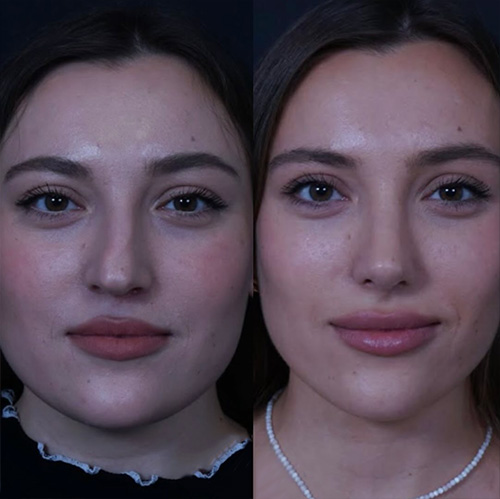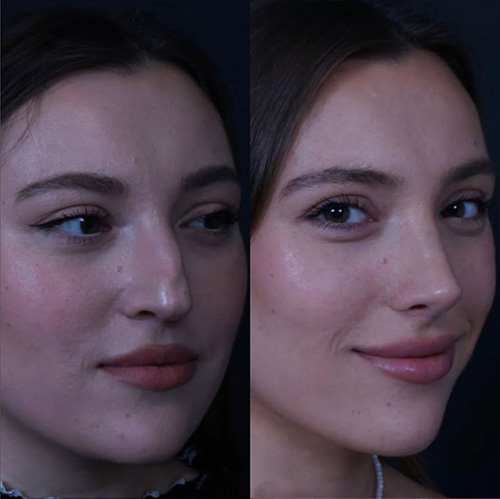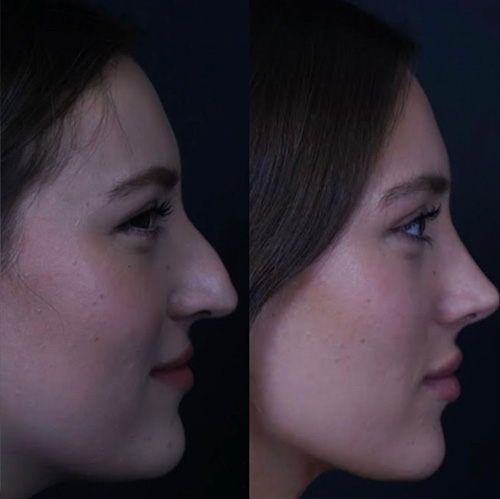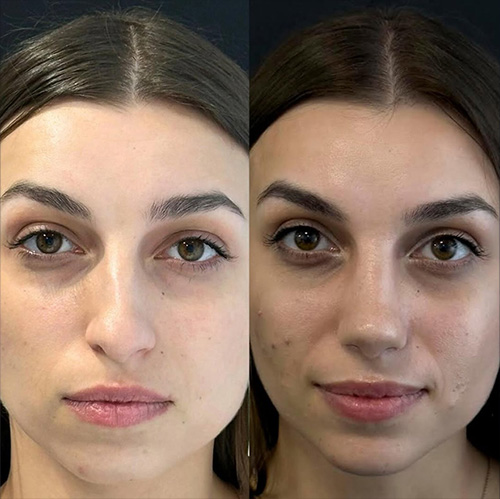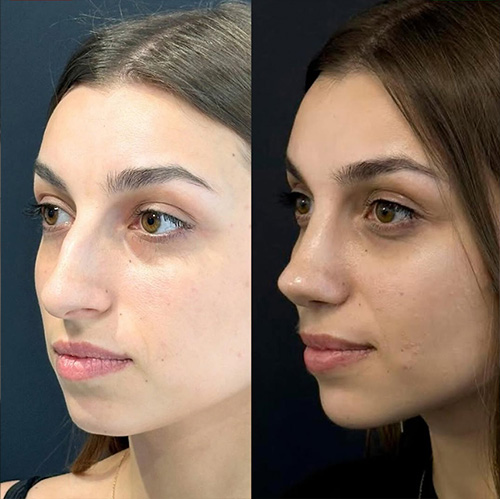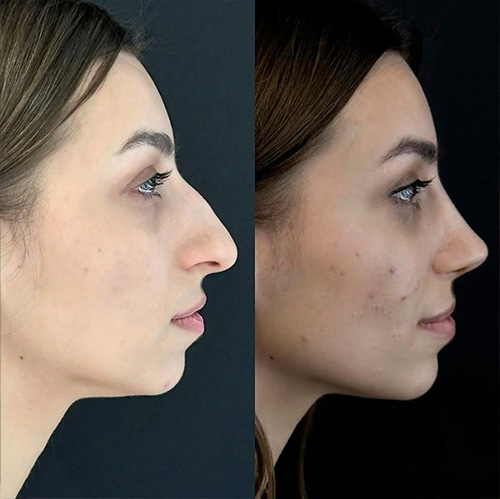Rhinoplasty

Nose Aesthetics (Rhinoplasty)
Rhinoplasty is a delicate and personalized surgery performed to provide a natural appearance harmonious with your face and to enable healthier breathing. With over 13 years of plastic surgery experience, I have performed more than 3,000 rhinoplasties. Every patient is different—therefore, so is every nose. My primary goal in these operations is to correctly understand my patients’ expectations and achieve results that offer the most natural, healthy, and comfortable recovery process.
I mostly prefer the open, structural rhinoplasty technique. This allows me to reshape the inner structures of the nose with control and maintain the nasal form in the long term. For bone shaping, I use the state-of-the-art Piezo device, which avoids damaging surrounding tissues.
I have experience with many techniques including preservation rhinoplasty. Over time, I have refined and implemented the methods that yield the most reliable and successful outcomes. This allows me to achieve a nose that is both aesthetically and functionally harmonious with the face, while minimizing the need for revision.
My Surgical Technique
Surgery and Early Recovery Process
A total of 6 days' stay in Istanbul is sufficient for rhinoplasty. The process proceeds as follows:
Day 1: Upon your arrival in Istanbul, tests will be performed at the hospital and you will undergo a face-to-face evaluation.
Day 2: Surgery day. A 2 hour and 15 minute operation is performed under general anesthesia.
After the surgery, you will be taken to your room, where grooved silicone tampons will be inserted to allow you to breathe, and a plastic splint will be applied to your nose.
There is usually no swelling or bruising when you first leave. The pain is usually mild; 90% of patients do not need another painkiller after the first one.
Days 3-4: Swelling gradually increases, but this is not painful. In rare cases, slight bruising may occur. During this period, patients can usually go on city tours without any problems.
These days, tampons can cause congestion in the nose and make it difficult to sleep at night. This is usually the most difficult part of the surgery.
Day 5: Silicone tampons and nasal splints are removed.
Silicones do not adhere to tissue, making them easy and painless to remove.
A nostril retainer is inserted into the nose to help maintain its shape. This device can be removed and cleaned, and should be used for one month.
Day 6: You may take a flight.
Late Recovery Process
The healing process depends largely on skin thickness:
1) In patients with thin skin, approximately 90% of healing is completed in about 3 months.
2) In patients with thick skin, this period may be extended up to 1 year.
But don't let that scare you; from the very first days after the surgery, you will notice that your nose is much more beautiful, elegant, and suits your face better than before.
I always advise my patients to enjoy the process rather than impatiently waiting for results. Because it is just as important to feel comfortable and confident with your nose as it is to simply have a beautiful nose.
Customized Design in Rhinoplasty
Rhinoplasty is not a standard procedure that is performed in the same way for everyone. This is because every face, every nose, and every expectation is different. For this reason, in aesthetic surgery, we do not work with a “one-size-fits-all” approach to beauty, but rather with personalized solutions.
When designing a nose, we do not attempt to copy the nose of any celebrity or other person. Instead, we combine your expectations with my professional knowledge and experience to create a unique design that suits all the structural features of your face.
During this process;
1) The current shape of your nose,
2) The overall harmony of your face,
3) Your forehead, midface, and chin proportions are carefully evaluated.
The result is a natural, healthy nose design that fits your face perfectly and is unique to you. This approach allows us to achieve a result that both complements your face and makes you happy.
Because in cosmetic surgery, the most valuable thing is not for someone looking at your face to say, “Your nose looks great,” but rather, “Your face looks beautiful.”
Natural Nose or Artificial Nose?
Some of my patients express concerns before surgery, saying things like, “I don't want my nose to be upturned,” or “I don't want it to be curved; I want it to look very natural.” Others say, “I want it to be obvious that I've had surgery; I want my nose to look very stylish.”
In fact, it is impossible to say that either of these two approaches is completely right or completely wrong. Because a “stylish” nose does not necessarily mean that it is “unnatural.” Similarly, a “non-stylish” nose may not always look natural.
The reason a nose does not look natural is usually not because of its flashy shape, but because of noticeable technical flaws that arise after surgery. The most common ones we encounter are as follows:
* Hanging Columella: Excessive sagging of the columella structure between the two nostrils
* Alar Retraction: Appearance of the nostrils being pulled up excessively
* Pinch Deformity: The tip of the nose appears as if it has been pinched with a clothespin.
* Reverse V: A distinct fracture line at the point where the nasal bone and cartilage meet.
* Supratip Deformity: The area just above the tip of the nose appears swollen, while the bony part appears sunken.
In addition, the concern that “my nostrils should not be visible when viewed from the front” is also a common concern. However, this is usually caused by anatomical problems such as a drooping columella or retracted nostrils. When these types of problems do not exist, a raised nose does not cause the nostrils to be visible.
In conclusion, the goal of rhinoplasty is to
The goal is to achieve a nose that suits your face, is aesthetically elegant, functionally healthy, and looks natural.
And yes — a snobby nose can be natural too.
Because there are also upturned, curved but extremely natural noses in nature. The nose we design to suit your face, needs, and aesthetic expectations can look both stylish and natural when done with the right technique.
Nose Aesthetics and Healthy Breathing
When it comes to nose aesthetics, most people only think about the external appearance of the nose. However, an aesthetic nose should also come with healthy breathing.
The inability to breathe comfortably through the nose is primarily caused by three main factors:
1. Septal Deviation (Nasal Deviation)
This is one of the most common problems we encounter. The septum is a structure located in the center of the nose that separates the two nostrils. It consists of cartilage at the front and bone tissue at the back. While it is ideal for this structure to be straight, most people have congenital or acquired deviations. This deviation is called septal deviation. If this deviation significantly narrows the airway in one nostril, breathing problems become inevitable. Correcting septal deviation is already a natural part of the process in a successful rhinoplasty surgery.
2. Enlargement of the Nasal Turbinates (Concha/Turbinate)
Nasal turbinates are very valuable structures that humidify and warm the air we breathe. However, especially in people with allergies, these turbinates can grow permanently. In such cases, patients complain of constant nasal congestion, postnasal drip, and mouth breathing. During rhinoplasty, these enlarged turbinates are reduced in size. However, as long as the allergic triggers remain, these turbinates may grow again in subsequent years. In such cases, a customized treatment plan is developed for the patient.
3. External Valve Insufficiency (Nasal Stenosis)
In some noses, especially those with structurally weak cartilage, such as Middle Eastern types, or after previous unsuccessful nose surgeries, the nostrils do not remain sufficiently open. This condition is called external valve insufficiency and can seriously impede breathing. With the proper techniques in rhinoplasty, the cartilages in this area can be supported to provide permanent solutions in terms of both shape and function.
In conclusion:
A successful nose job should not only improve the aesthetic appearance but also improve the quality of breathing. With a rhinoplasty performed by the right hands, all these problems that hinder breathing can be eliminated during the same surgery. Because a beautiful nose is only truly successful if it is a nose that breathes well.
Complementary Procedures Combined with Rhinoplasty
Rhinoplasty plays a very decisive role in facial beauty because the nose is located right in the center of the face. However, in some of my patients, it may not be enough to only intervene on the nose in order to make it look beautiful enough.
In particular, when I begin to evaluate the noses of some of my patients who say, “My nose is too big,” I see that there are actually significant volume deficiencies in the structures surrounding the nose—the forehead, chin, and midface. Volume loss in these areas can cause the nose to appear larger than it actually is. In such cases, even if we reduce the size of the nose, the surrounding structures are weak, so the nose will not blend in well with the face. Even if the surgery is technically successful, the patient may not achieve the desired result. This can lower the patient's satisfaction level and prevent them from receiving the positive feedback they expect from those around them.
That is why I recommend complementary procedures in addition to rhinoplasty for some of my patients. These procedures strengthen the supporting structures around the nose and ensure that the nose is more harmoniously balanced with the face:
1. Fat Injection (Lipofilling):
The person's own fat, usually taken from the abdomen, waist, or inner thighs, is purified through special processes and injected into the areas of the face where it is needed. Fat injections applied to deep tissues in areas such as the forehead, cheekbones, and midface increase volume in these areas and support the nose. It also has positive effects on skin quality.
2. Chin Augmentation – Silicone Implant:
A small incision of approximately 2 cm is made under the chin, and a specially prepared hard silicone implant is placed just in front of the bone at the tip of the chin. This procedure makes the tip of the chin more prominent, allowing the nose to appear more harmonious with the overall proportions of the face. It is a particularly effective application in terms of facial profile.
3. Chin Tip Filler:
As a more practical and non-surgical method, chin augmentation with fillers may also be preferred. In this procedure, performed in a clinical setting, fillers are applied to the deep tissue to shape the chin and achieve facial balance.
Realistic Expectations and Limitations in Rhinoplasty
Although rhinoplasty surgery can make significant changes to the shape of the nose and often allows me to create the nose my patients dream of, in some cases we encounter certain limitations and difficulties in shaping the nose.
It is very important to clearly identify such limitations before surgery. This is because satisfaction with cosmetic surgery is only possible if the result meets or exceeds the patient's expectations. Even a technically successful surgery may not satisfy the patient if there is a difference between the patient's mental image of the nose and the actual result. This can lead to disappointment for both the patient and the surgeon.
Therefore, it is necessary to talk to the patient in detail and clearly before surgery, especially when the following three basic conditions are identified:
1. Large Nose Tip:
The bridge of the nose, or the arch area, has a simpler anatomical structure, and the skin covering this area is generally thinner and more flexible. Therefore, significant reductions can be made in the arch area. However, the tip of the nose is not the same.
The anatomy of the tip of the nose is complex; the cartilage structures and soft tissues located here vary greatly from person to person. In particular, in individuals with weak cartilage and thick, voluminous skin and soft tissue, reduction of the nasal tip may be limited. Otherwise, the structures that provide the nostril opening may weaken, causing depressions in the external appearance, or the tissues may be unable to adapt to the new shape.
However, even if the tip of the nose is large, if the cartilage is strong and the skin is thin, much more effective reductions can be achieved. In other words, it is necessary to make a plan tailored to the individual anatomy of each patient.
2. Thick Nose Skin:
Thick nasal skin is an important factor in cosmetic surgery. If the skin is thick, no matter how well the underlying structure is shaped, it may be more difficult to see the new shape from the outside. In addition, postoperative edema (swelling) may last longer in patients with thick skin.
But don't let that worry you. In the more than 3,000 rhinoplasty surgeries I have performed to date, I can say that more than 80% of my patients have thick nasal skin.
When approaching surgery with realistic expectations, patients with thick nasal skin can also be extremely satisfied with the results. The right technique and proper information ensure that this condition is not an obstacle, but simply a feature that needs to be taken into consideration.
3. Asymmetrical Facial Structure:
If you have noticeable asymmetry in your face—for example, if one nostril is higher than the other or your nose appears to be deviated from the midline of your face—this will affect the outcome of rhinoplasty.
This is because facial asymmetry makes it technically difficult to make both sides of the nose completely equal and can also make it visually incompatible. A completely symmetrical nose can look out of place on an asymmetrical face. Therefore, the goal is to make the nose compatible with your face.
In such cases, small differences may remain between the two sides of your nose after surgery. These differences are visible when looked at closely, but they usually appear natural within the overall aesthetic harmony of the face.
In conclusion:
My goal is to make you happy with the surgery I will perform on you. The key to happiness is to focus on the things we can change and to accept the structural features we cannot change together.
With accurate information, realistic expectations, and personalized planning, every nose can reach its full potential.

